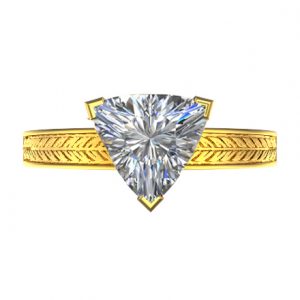
Defining Trilliant cut might mean closing down on the possibilities of this particular cut. Spun out from the geometric shape “triangle”, a trilliant cut has many names, such as Trillian, trillion and more. A Trilliant-cut stone is essentially triangular in its outline, with a combination of curves and projections along the sides. Trilliant cut stones have a table on top like all other cuts, but with variable shapes.
Origin
The cut shares its inventors with the Asscher cut, the Asscher brothers of Holland. Its birthplace is the beautiful city of Amsterdam. The cut travelled from Europe all the way to the United States, in the year 1962, where it came to be patented by a certain Henry Meyer for his Diamond Company in New York. Interestingly, the cut is no longer trademarked for the patent with the said company has expired. The term is now a common word used to call any gemstone which has a triangular body. The term has outdone its implications in the 21st century where it is also used to refer to cabochon and step-cut stones. GIA too uses the term, to refer to all those gemstones that are not branded.
The Curved and Uncarved
The cut shifts in its facets and that is what makes it unique among all others. It is particularly preferred for its very high brilliance. The Trilliant cut diamonds have the fire in them that round and princess cuts have acquired undisputed fame for. The stones are shaped to the right depth and that makes room for very good scintillation. The lapidaries usually follow the length to width ratio of 1:1, inclusive of the uncarved edges. The Trilliant stones that are uncarved make good articles for accent stones which usually find space on the either side of the center stone in rings.
As for the Curved stones, it is only a subtler equivalent of the uncarved cut. These ones have 3 different soft points which add up to the vertices of a triangle. However the L/W ratio still remains the same which obviously works to keep the proportions normal. The stones of curved Trilliant cut are normally used as solitary and accent gems.
Accent Suitability
This cut is mostly used to shape accent pieces that are used to adorn the centerpiece of a ring. The shape works great to highlight gems of lighter colors. It is often used on diamonds, and more often on other gemstones such as beryl, sapphire and aquamarine.





